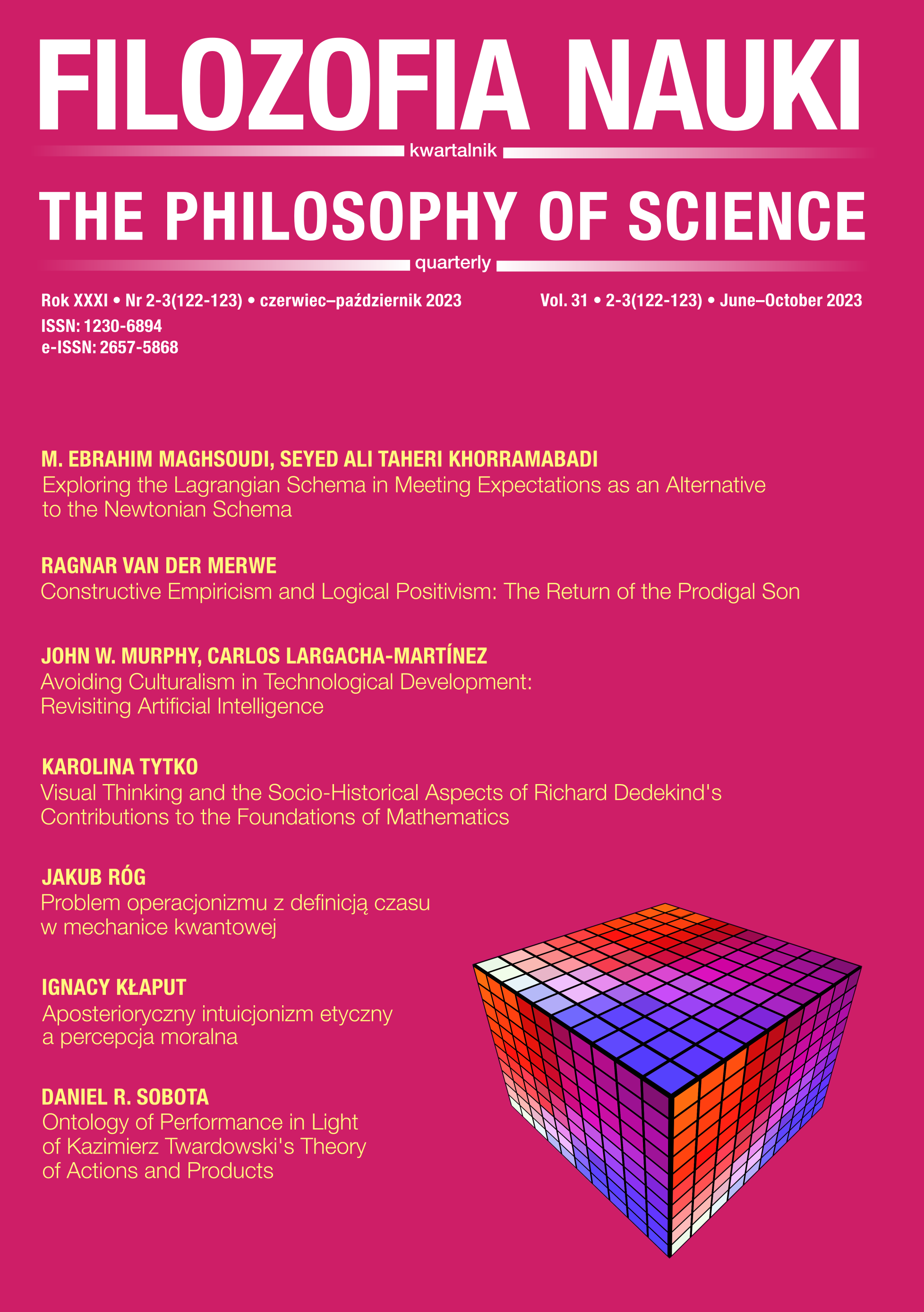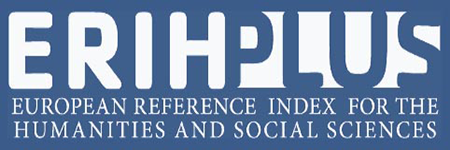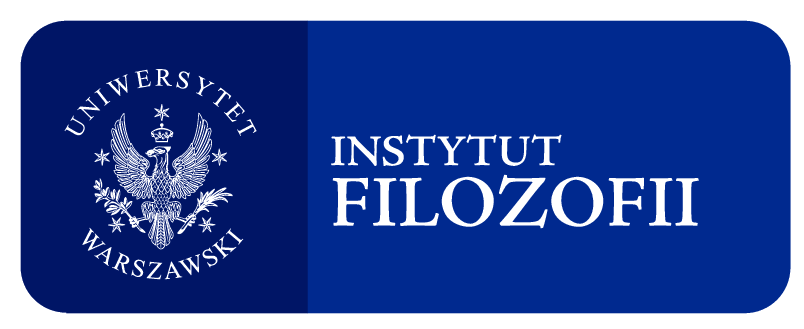Exploring the Lagrangian Schema in Meeting Expectations as an Alternative to the Newtonian Schema
DOI:
https://doi.org/10.14394/filnau.2023.0014Słowa kluczowe:
Newtonian schema, Lagrangian schema, cosmology, time, multiverse, Lee Smolin, Ken WhartonAbstrakt
Lee Smolin believes that current physics and modern cosmology are in crisis because of the application of “the Newtonian schema,” according to which the universe is like a computer that receives initial conditions, and the governing laws then generate its subsequent states. According to him, it is the application of the Newtonian schema that has led to common but false beliefs, such as the belief in the unreality of time or the belief in the reality of the multiverse. It is necessary, Smolin concludes, to abandon this schema in order to overcome this crisis, but he proposes no alternative methodology. The only available alternative has been proposed by Ken Wharton, who suggests replacing the Newtonian schema with “the Lagrangian schema,” which, unlike the Newtonian schema, offers a holistic and global point of view. According to the Lagrangian schema, the system under study or the world as a whole is examined in an all-at-once manner, rather than as the time evolution of a timeless part. This article aims to investigate Smolin’s criticisms of the Newtonian schema and Wharton’s proposal for replacing it with the Lagrangian schema. We intend to show that although the Lagrangian schema does not suffer from some of the problems of the Newtonian schema, it still faces some similar challenges. For example, even if one uses the Lagrangian schema, time can still be unreal, and the multiverse can exist. Thus, Smolin is likely to find the Lagrangian schema problematic.
Bibliografia
Adlam E. (2018), “Spooky Action at a Temporal Distance,” Entropy 20(1), 41. https://doi.org/10.3390/e20010041
Adlam E. (2022), “Determinism beyond Time Evolution,” European Journal for Philosophy of Science 12(4), 73. https://doi.org/10.1007/s13194-022-00497-3
Baez J. C. and Wise D. K. (2019), Lectures on Classical Mechanics, Manuscript. Available online at https://math.ucr.edu/home/baez/classical/texfiles/2005/book/classical.pdf.
Burton H. (ed.) (2021), Examining Time: A Conversation with Lee Smolin, Open Agenda Publishing. https://doi.org/10.2307/j.ctv22jnph7
Chen E. K. and Goldstein S. (2022), Governing without a Fundamental Direction of Time: Minimal Primitivism about Laws of Nature, [in:] Rethinking the Concept of Law of Nature: Natural Order in the Light of Contemporary Science, Y. Ben-Menahem (ed.), Springer, 21–64. https://doi.org/10.1007/978-3-030-96775-8_2
Chen R. and Wu X. (2016), “A Note on the Equivalence of Post-Newtonian Lagrangian and Hamiltonian Formulations,” Communications in Theoretical Physics 65(3), 321. https://doi.org/10.1088/0253-6102/65/3/321
Curiel E. (2014), “Classical Mechanics Is Lagrangian; It Is Not Hamiltonian,” The British Journal for the Philosophy of Science 65(2), 269–321. https://doi.org/10.1093/bjps/axs034
Faraoni V. (2023), Cosmic Analogies: How Natural Systems Emulate the Universe, World Scientific Publishing Europe Ltd. https://doi.org/10.1142/q0396
Gaspar Y. and Tambor P. (2023), “The Laws of Nature and the Problems of Modern Cosmology,” Foundations of Science 29, 847–870. https://doi.org/10.1007/s10699-023-09904-1
Goldstein H., Poole C., and Safko J. (2001), Classical Mechanics, Addison Wesley.
Gopakumar A. and Königsdörffer C. (2005), “Deterministic Nature of Conservative Post-Newtonian Accurate Dynamics of Compact Binaries with Leading order Spin-Orbit Interaction,” Physical Review D 72(12), 121501. https://doi.org/10.1103/PhysRevD.72.121501
Healey R. and Gomes H. (2022), Holism and Nonseparability in Physics, [in:] E. N. Zalta (ed.), The Stanford Encyclopedia of Philosophy, https://plato.stanford.edu/archives/spr2022/entries/physics-holism/.
Königsdörffer C. and Gopakumar A. (2005), “Post-Newtonian Accurate Parametric Solution to the Dynamics of Spinning Compact Binaries in Eccentric Orbits: The Leading Order Spin-Orbit Interaction,” Physical Review D 71(2), 024039. https://doi.org/10.1103 /PhysRevD.71.024039
Lanczos C. (1952), The Variational Principles of Mechanics, University of Toronto Press.
Levin J. (2003), “Fate of Chaotic Binaries,” Physical Review D 67(4), 044013. https://doi.org/10.1103/PhysRevD.67.044013
Linde A. (2004), Inflation, Quantum Cosmology, and the Anthropic Principle, [in:] Science and Ultimate Reality: Quantum Theory, Cosmology, and Complexity, J. D. Barrow, P. C. Davies, and C. L. Harper (eds.), Cambridge University Press, 426–458. https://doi.org/10.1017/CBO9780511814990.023
Maghsoudi M. E. and Taheri Khorramabadi S. A. (2024), “The Newtonian Schema vs. the Lagrangian Schema: An Evaluation of Smolin’s and Wharton’s Criticism of the Newtonian Schema,” Philosophy of Science (IHCS) 13(2), in Persian, 265–292.
Masoumi S. (2014), “Multiverse in Physics and Its Philosophical Implications,” Zehn 14(54), in Persian, 157–210.
Masoumi S., Golshani M., and Sheikh Jaberi M. M. (2014), “Multiverse and Testability,” Philosophy of Science (IHCS) 3(6), in Persian, 73–98.
Nambu Y. (1952), “On Lagrangian and Hamiltonian Formalism,” Progress of Theoretical Physics 7(2), 131–170. https://doi.org/10.1143/ptp/7.2.131
North J. (2009), “The “Structure” of Physics: A Case Study,” The Journal of Philosophy 106(2), 57–88. https://doi.org/10.5840/jphil2009106213
North J. (2021a), Formulations of Classical Mechanics, [in:] The Routledge Companion to Philosophy of Physics, E. Knox and A. Wilson (eds.), Routledge, 21–32. https://doi.org/10.4324/9781315623818-5
North J. (2021b), Physics, Structure, and Reality, Oxford University Press. https://doi.org/10.1093/oso/9780192894106.001.0001
Olson H. F. (1943), Dynamical Analogies, New York: D. Van Nostrand Company.
Rees M. (2003), Other Universes: A Scientific Perspective, [in:] God and Design: The Teleological Argument and Modern Science, N. A. Manson (ed.), Routledge, 210–220. https://doi.org/10.4324/9780203398265_chapter_11
Schiffer M. M. and Bowden L. (1984), The Role of Mathematics in Science, Washington, D.C.: The Mathematical Association of America. https://doi.org/10.5948/UPO9780883859452
Smolin L. (1992), “Did the Universe Evolve?” Classical and Quantum Gravity 9, 173–191. https://doi.org/10.1088/0264-9381/9/1/016
Smolin L. (1997), The Life of the Cosmos, Oxford: Oxford University Press.
Smolin L. (2001), Three Roads to Quantum Gravity, New York: Basic Books.
Smolin L. (2007), The Trouble with Physics: The Rise of String Theory, The Fall of A Science, and what Comes Next, Boston–New York: Houghton Mifflin Harcourt.
Smolin L. (2009), “The Unique Universe,” Physics World 22(6), 21–26. https://doi.org/10.1088/2058-7058/22/06/36
Smolin L. (2012), “The Culture of Science Divided against Itself,” Brick Magazine 88.
Smolin L. (2013a), “A Perspective on the Landscape Problem,” Foundations of Physics 43, 1–45. https://doi.org/10.1007/s10701-012-9652-x
Smolin L. (2013b), Time Reborn: From the Crisis in Physics to the Future of the Universe, Boston–New York: Houghton Mifflin Harcourt.
Smolin L. (2015), “Temporal Naturalism,” Studies in History and Philosophy of Science Part B: Studies in History and Philosophy of Modern Physics 52, 86–102. https://doi.org/10.1016/j.shpsb.2015.03.005
Susskind L. (2007), The Anthropic Landscape of String Theory, [in:] Universe or Multiverse, B. Carr (ed.), Cambridge University Press, 247–266. https://doi.org/10. 1017/CBO9781107050990.018
Tegmark M. (2008), “The Mathematical Universe,” Foundations of Physics 38(2), 101–150. https://doi.org/10.1007/s10701-007-9186-9
Thornton S. T. and Marion J. B. (2004), Classical Dynamics of Particles and Systems, Brooks/Cole.
Unger R. M. and Smolin L. (2015), The Singular Universe and the Reality of Time, Cambridge: Cambridge University Press. https://doi.org/10.1017/CBO9781139696487
Wallace D. (2000), The Quantization of Gravity – An Introduction, preprint, arXiv: gr-qc/0004005.
Weinstein S. and Rickles D. (2024), Quantum Gravity, [in:] The Stanford Encyclopedia of Philosophy, E. N. Zalta and U. Nodelman (eds.), https://plato.stanford.edu/archives/spr2024/entries/quantum-gravity/.
Wharton K. B. (2013a), “Against the Cosmic Computer,” New Scientist, 30–31. https://doi.org/10.1016/S0262-4079(13)60354-1
Wharton K. B. (2013b), Lagrangian-only Quantum Theory, Preprint, arXiv:1301.7012.
Wharton K. B. (2015a), Reality, No Matter How You Slice It, [in:] It from Bit or Bit from It? On Physics and Information, A. Aguirre, B. Foster, and Z. Merali (eds.), Springer, 181–196. https://doi.org/10.1007/978-3-319-12946-4_16
Wharton K. B. (2015b), The Universe is not a Computer, [in:] Questioning the Foundations of Physics: Which of Our Fundamental Assumptions Are Wrong? A. Aguirre, B. Foster, and Z. Merali (eds.), Springer, 177–189. https://doi.org/10.1007/978-3-319-13045-3_12
Wharton K. B. (2016), “Towards a Realistic Parsing of the Feynman Path Integral,” Quanta 5(1), 1–11. https://doi.org/10.12743/quanta.v5i1.41
Wu X., Mei L., Huang G., and Liu S. (2015), “Analytical and Numerical Studies on Differences between Lagrangian and Hamiltonian Approaches at the Same Post-Newtonian Order,” Physical Review D 91(2), 024042. https://doi.org/10.1103/PhysRevD.91.024042
Pobrania
Opublikowane
Jak cytować
Numer
Dział
Licencja
Prawa autorskie (c) 2023 M. Ebrahim Maghsoudi, Seyed Ali Taheri Khorramabadi

Utwór dostępny jest na licencji Creative Commons Uznanie autorstwa – Użycie niekomercyjne – Bez utworów zależnych 4.0 Międzynarodowe.



















 Filozofia Nauki | ISSN 1230-6894 | e-ISSN 2657-5868
Filozofia Nauki | ISSN 1230-6894 | e-ISSN 2657-5868